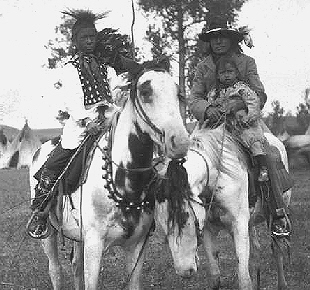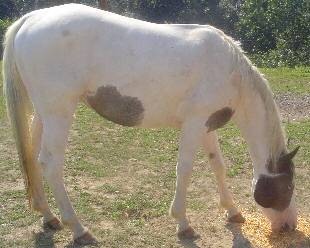 Essentially a variation of the Medicine Hat, a War Bonnet's "hat" extends from the ears down to the throatlatch -- giving the impression of an Indian feathered war headdress. It also generally has a "shield." Your fellow has both of those features.
Essentially a variation of the Medicine Hat, a War Bonnet's "hat" extends from the ears down to the throatlatch -- giving the impression of an Indian feathered war headdress. It also generally has a "shield." Your fellow has both of those features.
Q&A Questions and Answers:

My 3 year old paint is almost all white. He has on his right side one spot, one on his underbelly, and on the right side of his face it's all black, which continues all the way across his forehead. He also has very light blue eyes. He is white on his left side.
Is he a splash white or is he a medicine head? Can you help please?
Let me say up front that your horse's coloring is not an easy call. (If it were easy, you wouldn't have asked for help, right?) And I'm at an added disadvantage because I can only see one side of the horse. If some expert in Pintos or Paints wishes to disagree with the way I'm calling it, I won't be offended in the least.
A handy guideline for identifying a Splash White is to think of it as having been dropped in a bucket of white paint and then taking a drink from that bucket. As a result, Splash Whites tend to be "top heavy" in color, with more coloring toward the top of the head and body. Also, the areas of color have fairly clean edges, rather than having the white blur or fade into the color. Some Splash Whites are hearing impaired, but that's only in a few horses.
A Medicine Hat (not medicine head, as it is sometimes mis-pronounced) is distinguished by coloring over the ears and top of the head -- as though it is wearing a hat. It is also usually marked with a "shield" or spot of color over the chest.
So, which do I think your horse is? Neither. I think it's a War Bonnet.
I'm ruling out the Splash White because your horse carries the color toward the bottom of the body, rather than the top. In addition, the belly spot has a lacy edge, rather than the smooth edge typical of a Splash White.
 Essentially a variation of the Medicine Hat, a War Bonnet's "hat" extends from the ears down to the throatlatch -- giving the impression of an Indian feathered war headdress. It also generally has a "shield." Your fellow has both of those features.
Essentially a variation of the Medicine Hat, a War Bonnet's "hat" extends from the ears down to the throatlatch -- giving the impression of an Indian feathered war headdress. It also generally has a "shield." Your fellow has both of those features.
Medicine Hats and War Bonnets were highly prized as "good medicine" by the Plains Indians, such as the Sioux Indians at right who were photographed on their Medicine Hats around 1890. Notice the dark color on the ears and top of the head as well as the colored "shields" on the horses' chests. (Photo courtesy of the Library of Congress.) The large white area of the hide also provided a wonderful "canvas" upon which various ceremonial symbols could be drawn.
All three -- Splash White, Medicine Hat, and War Bonnet -- usually, but not always, have blue eyes.
I hope this helps -- and I'll be looking forward to some e-mails from visitors to my site who have more experience with the topic than I do!
![]() Return to Questions and Answers Index
Return to Questions and Answers Index
![]() Return to the "Learning More About Horses..." page
Return to the "Learning More About Horses..." page
COPYRIGHT © 2006 BOB LEMEN, GRAND RAPIDS,
MINNESOTA. ALL RIGHTS RESERVED.
The contents of this document are not for reproduction.